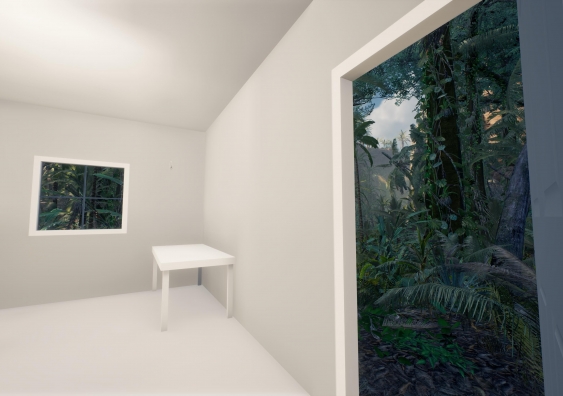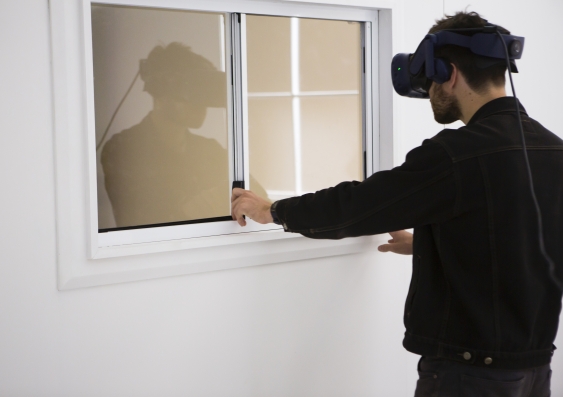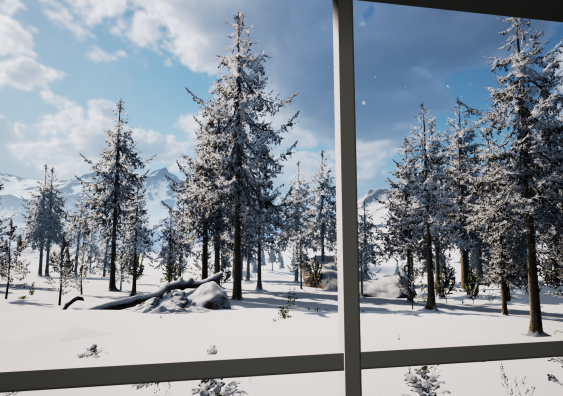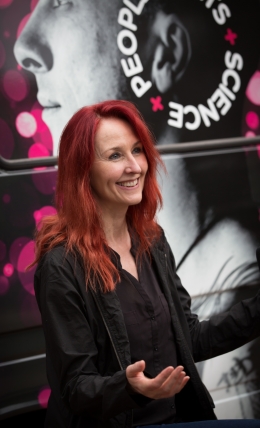Virtual reality experience which improves mood to be used in suicide prevention
A VR experience developed in partnership with people with lived experience of suicidality has demonstrated rapid increases in positive mood.
A VR experience developed in partnership with people with lived experience of suicidality has demonstrated rapid increases in positive mood.

A team of researchers from the Black Dog Institute and UNSW has received an innovation grant to further investigate an immersive virtual-reality experience which improves peopleās mood and potentially reduces suicidal feelings.
The grant from the Suicide Prevention Research Fund, administered by Suicide Prevention Australia,Ā will allow the experience to be exhibited in Brisbane and tested as a suicide prevention tool in partnership with Metro South Health.
The installation project, called The Edge of the Present, was developed for The Big Anxiety festival at UNSW in 2019. The project was led by Scientia Professor Jill Bennett from UNSW Art & Design and Professor Katherine Boydell from the Black Dog Institute, and developed in partnership with people with lived experience of depression and suicidality.
The ten-minute mixed-reality experience, designed by artist Dr Alex Davies from UNSW Art & Design, explores virtual landscapes within a purpose-built room. It gives the user the experience of being in a tropical rainforest one moment and a snow-covered mountain or desert landscape the next.
āThis research is the first to assess the effectiveness of such an immersive mixed-reality experience as an intervention for depression and hopelessness. It does so by rapidly increasing positive mood and stimulating positive āfuture thinkingā,ā says Prof. Bennett.
The experience aims to cultivate the capacity for future thinking by encouraging positive actions that are rewarded in an instant feedback loop.
āThe experience is not just a passive one but involves the user making choices to open doors and windows ā¦ each choice is rewarded by positive sensation. So, for example, you open a door and feel the breeze on your face, or step out into the warmth of a sun-baked meadow,ā says Prof. Bennett.
āOn the one hand itās relentlessly positive ā¦ There are all these beautiful scenes, itās impossible not to like. But on the other hand, itās important that the user has agency and that this very positive sensation, and this amazingly beautiful resplendent scene, is coming as a result of your direct action.ā

The project explored ways to cultivate future thinking beyond simple abstract planning through a series of workshops with young men who had survived suicide attempts. Photo: Alex Davies
The Edge of the Present is part of Prof. Bennettās Felt Experience & Empathy Lab [fEEL] that investigates subjective experience of mental health, trauma, life course events and ageing.
Funded through Prof. Bennett's ARC Australian Laureate Fellowship, the Lab brings together psychologists, clinical trauma specialists and immersive arts designers to examine what people are āthinking, feeling, doingā with a focus on āthe nature of relationships and how we change thoseā, she says.
The Lab uses emerging immersive visualisation technology to study subjective experiences like suicidality and ageing. It has a larger social goal of improving our understanding of stigmatised and devalued populations, and remediating the effects of stigma and prejudice.
āWe use the technology to not only convey the experience, but to create different possibilities for acting that are quite enriching, whether for the people with that lived experience or the people around them,ā she says.
āIt's 90 per cent about the process and how beneficial it is for people, and then there may be a high-end art output which takes the work to another level and to different audiences, but it's never just about the art.ā
Currently around 65 per cent of people with mental health concerns do not seek help, she says.
If you only work with people who present in a health environment, āyou only have a small proportion of the people that you want to treat in your program,ā she says. āI think there's increasing interest from a health perspective in operating outside of those confines.ā

Users navigate through a series of striking virtual landscapes with accompanying sensory effects: users experience the feel of the breeze, the sun on their face and other effects. Photo: Alex Davies
The Edge of the Present originated in a project, funded by ARC and the NSW Ministry of Mental Health, that Prof. Bennett ran with Dr Davies and some UK-based cognitive neuropsychologists over several years. It looked at memory, memory loss, amnesia, and future thinking which is very similar to the process of memory from the neuro-psychological point of view, Prof. Bennett says.
āWe were looking at when, and under what conditions, people have difficulty producing, creating new memories or the future-oriented version of that: imagining themselves in future scenarios.
āThereās evidence to suggest that people who are severely depressed have trouble not just remembering but [also] attaching emotion [and positive sensation] to memories. It's very hard to think of yourself having a pleasurable experience in the past or in the present.ā
The project explored ways to cultivate future thinking beyond simple abstract planning through a series of workshops with young men who had survived suicide attempts.
Working with people with lived experience is āfascinating [and] so valuable and revealingā, Dr Davies says. Drawing on insights from the workshops, the media artist created the mixed-reality platform that invites the user to āinvent the next ten minutesā.
Dr Davies develops āspatial narrative environments where people experience a story world, in physical space,ā that delivers an immediate sense of ābeing thereā, he says. The challenge of experimenting with form and content to create a compelling experience for this particular audience was important to him, he says.

The Edge of the Present starts with a sparsely furnished room that opens onto a series of beautiful vistas experienced on a sensory level. Photo: Jessica Maurer
The Edge of the Present starts with a sparsely furnished room that opens onto a series of beautiful vistas experienced on a sensory level.
The name came from a participant in one of the workshops who described this āfeeling of being stuck at the edge of the present where you can't move forward. You just can't see aheadā, Prof. Bennett says.
The focus turned to a kind of micro intervention, supporting users to make positive decisions on a manageable scale.
āYou're creating a future if you can make choices about the next few minutes ā even if you have minimal energy, you do a tiny thing for massive reward, you do another tiny thing for massive reward. You effectively transform this very bare environment,ā she says.
āIt's so important just to envisage that things can change, that you can make this shift, and not in an overly ambitious way, but just literally in five minutes to do something, see the shift."

Professor Jill Bennett with the Mobile Mood Lab at The Big Anxiety. Photo: Skyline Productions
The installation drew large queues at The Big Anxiety festival in 2019. āEven if you knew nothing about the suicide narrative, it's the kind of environment that people wanted to be in and really enjoyed being in,ā Prof. Bennett says.
The festival, a UNSW initiative in association with the Black Dog Institute, works alongside the Lab to create an open discussion about the state of mental health today. It supports diverse groups, with a particular focus on community-driven projects.
Professor Boydell of the Black Dog Institute ran the pilot study on the project during the festival in 2019. The research was funded by the Black Dog Instituteās NHMRC Centre of Research Excellence in Suicide Prevention and included 79 people, many with lived experience of depression and suicidality.
It involved some baseline testing of mood as well as a series of psychometric tests to measure impact on mood and some other indicators around future thinking and hopelessness.
The data from the pilot study showed the platform has capacity to induce immediate mood change, says Prof. Boydell.
āWe demonstrated that positive mood and well-being increased significantly post-intervention. Hopelessness scores decreased, as well as negative mood. So now we hope to replicate the study on a larger scale in Brisbane at a location which doesnāt have the stigma of a health agency,ā she says.
āNothing has made me feel instantly better [more] than this virtual-reality work,ā one participant in the pilot study reported. āThis is the seventh time that Iāve been back and I just canāt get enough of it. Maybe itās because I have an addictive personality, but I just feel like my mood is instantly better!ā
The Suicide Prevention Research FundĀ grant will see the installation exhibited later this year as part of The Big Anxiety festival in Brisbane, in partnership with Metro South Health. The team sees longer-term potential for the platform to be adapted for suicide prevention in care settings such as clinics and psychiatric emergency, providing a positive and hopefully beneficial experience for those in crisis.
āThis would be a world-first for psychiatric emergency, as these settings currently offer very little for patients to do. Acute patients are often accommodated in a room with nothing in it. So to offer patients such an environment would be a big shift, especially if the experience proves it can cultivate neural pathways for positive thinking,ā Professor Bennett says.
āThis is really about giving something that is pleasurable and self-driven to people, rather than something that's like medicine or a bitter pill that you have to swallow.
āIt's not like a medical intervention at all, it's like a game or engaging with an artwork. Itās what you want to be doing in your leisure time. So if that is something that can [through our further testing be proven to] have quite a dramatic effect on mood, that will be quite extraordinary.ā
If you or anyone you know needs help, support is available: